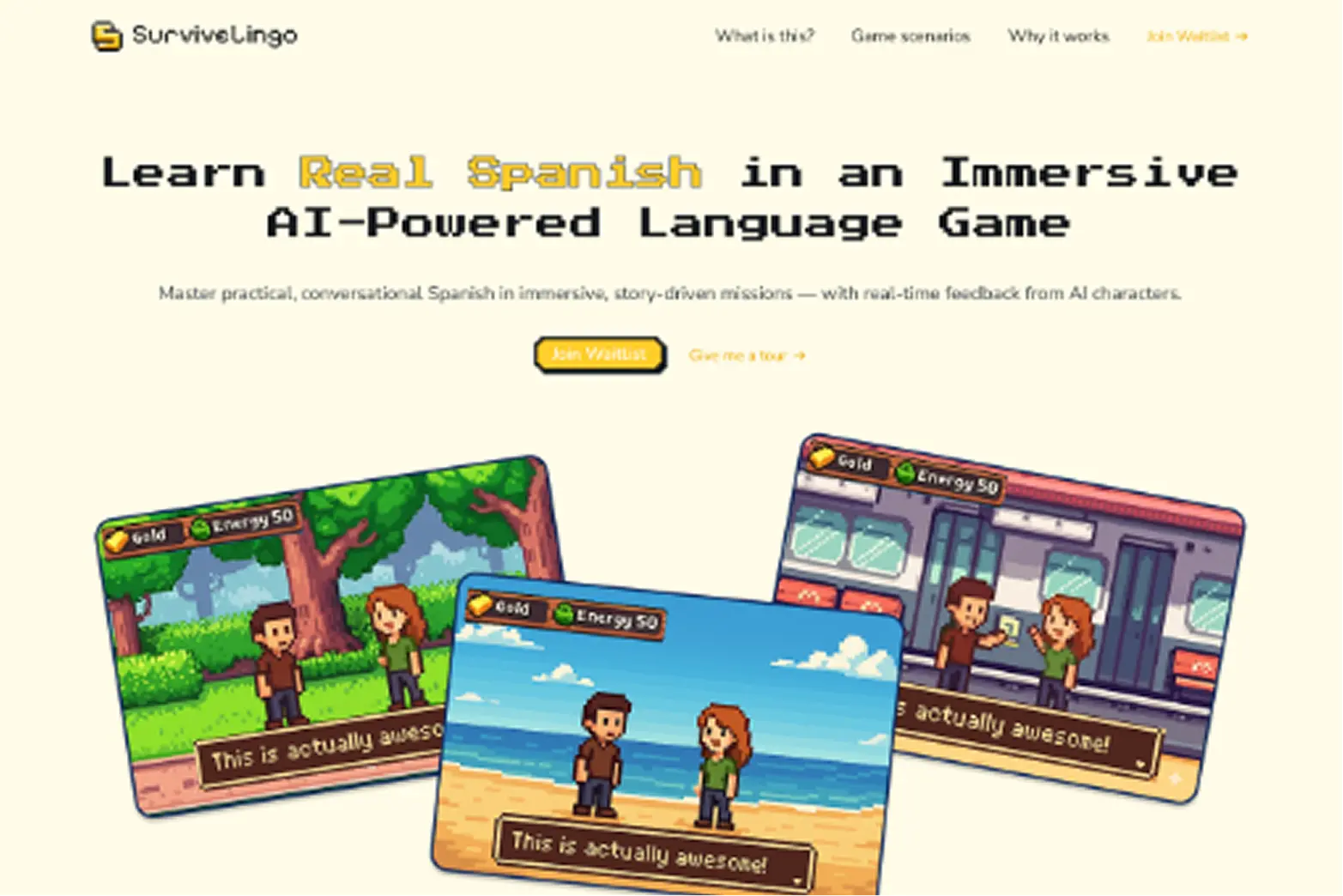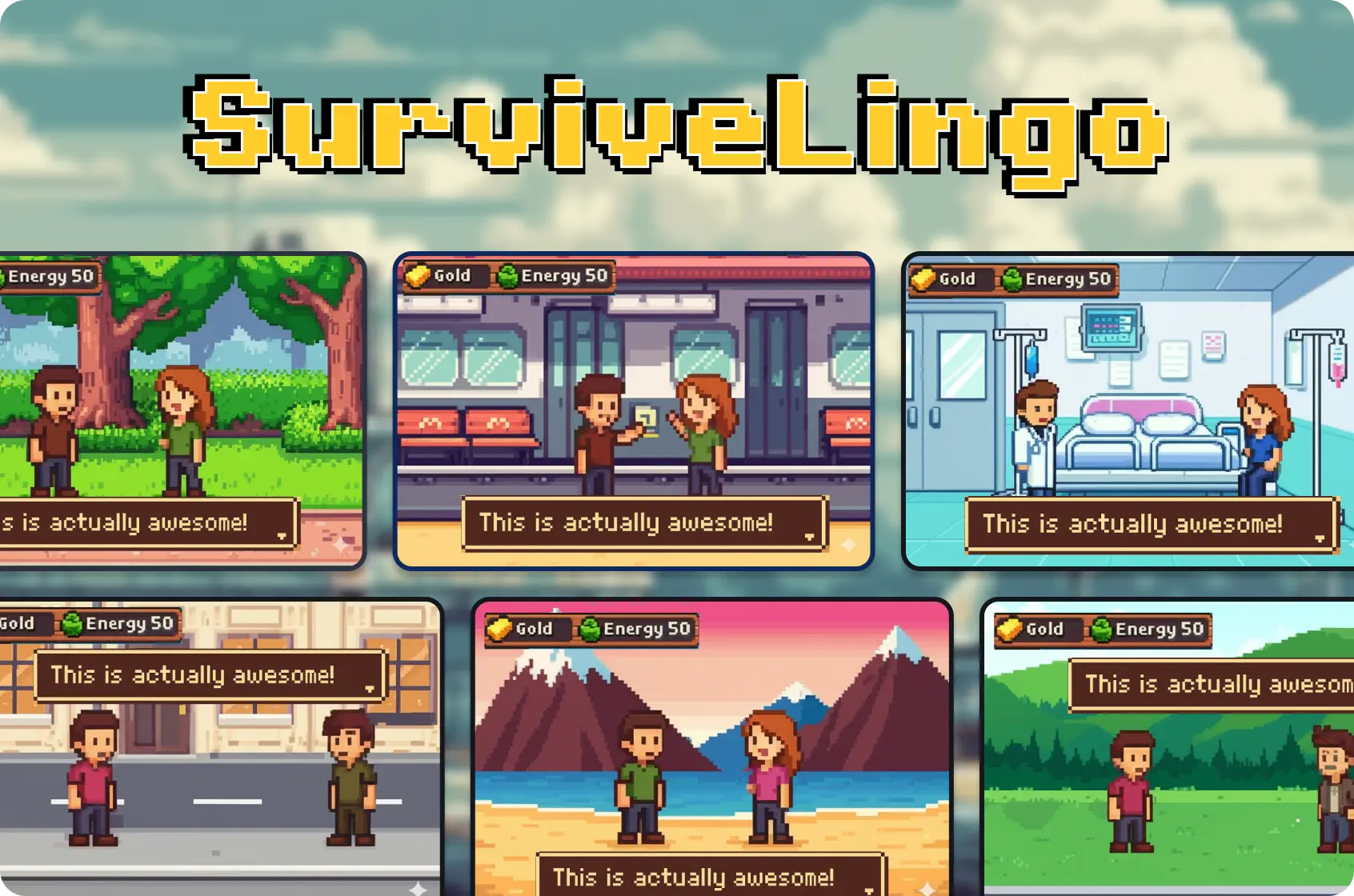1. Project Overview
SurviveLingo is redefining how people learn languages — not through flashcards or grammar drills, but through survival-based gameplay, where every conversation in Spanish moves the story forward. From navigating daily tasks to building relationships, players must use real language to succeed.
As an early-stage startup, the SurviveLingo team needed a strong MVP to demo their concept, validate investor interest, and prepare for a full product launch next year. That’s where Fynest stepped in — to help design and build a working mobile prototype that showcases the game’s potential while ensuring scalability and AI integrity for future growth

2. Why SurviveLingo Chose Fynest: A Tech Partner That Understands AI + Games
The SurviveLingo team was looking for more than developers — they needed a team who could:
- Architect believable, goal-oriented AI NPCs that adapt to player behavior.
- Implement AI models like TTS and STT while staying resource-efficient.
- Build a backend that could eventually scale into a full production release.
- Ensure gameplay logic and AI flows remain cohesive, immersive, and pedagogically sound.
They chose Fynest because of our unique mix of:
- Game logic expertise
- AI system design
- MVP and backend experience
- QA automation (especially for unpredictable AI outputs)
3. The Challenge: Making Language Learning Feel Real (Not Robotic)
Before working with Fynest, the SurviveLingo’s founder had a bold concept, but no technical implementation. Their biggest hurdles were:
- Creating Cohesive NPC Interactions: Random AI responses could break immersion or confuse learners.
- Making AI Conversations Feel Purposeful: Each NPC had to serve a goal and teach something — without sounding scripted.
- Balancing Cost & Performance: Real-time STT/TTS needed to work on mobile without draining resources.
- Validating Their Vision Fast: They needed an MVP that looked and felt like a real product — without overbuilding.
4. The Solution: A Smart, Scalable MVP That Proves the Vision
Here’s what we helped SurviveLingo bring to life:
- Immersive Gameplay MVP: A mobile app that showcases how AI + gamification can transform language learning.
- Cohesive AI Character System: NPCs that act consistently, teach effectively, and help players progress.
- Speech-Based Interaction: Integrated TTS/STT to simulate real conversations and improve fluency.
- Cloud-Ready Backend: Lightweight but scalable infrastructure, ready for future player growth.
- Tested AI Workflows: Automation that catches broken or nonsensical dialogue before it reaches users.
5.How Fynest Delivered: AI-Driven MVP Built for Learning & Engagement
a. Mobile MVP Development We built a playable mobile app that demonstrates the core gameplay loop: players enter immersive scenes (like a park, office, or restaurant) and interact with AI characters using voice and text. The MVP includes sample locations, multiple quests, and branching dialogues driven by the learner’s responses.
b. AI System Design for NPCs This was the heart of the project: we designed a system where NPCs act with believable intent, memory, and designed a system where NPCs act with believable intent, memory, and progression — all contributing toward helping the player reach the end goal of each mission. Every interaction reinforces language acquisition while maintaining story coherence.
c. Text-to-Speech & Speech-to-Text Integration To support verbal interaction, we integrated lightweight, low-latency interaction, we integrated lightweight, low-latency TTS and STT systems. This enabled voice-based conversations in real time — a critical part of making the learning experience feel natural and immersive.
d. Cloud-Based Backend MVP We set up the backend logic using a scalable, cloud-first infrastructure (AWS) — allowing room to grow as more players, NPCs, and language packs are introduced. This early architecture ensures smooth transition to future development stages.
e. QA Automation for AI Flows AI logic can be messy. We developed custom automated tests specifically automated tests specifically for testing AI logic flow, dialogue branching, and error-handling — ensuring every conversation remains functional and aligned with the intended learning path.
f. Ongoing Support As SurviveLingo iterates on their product, we continue to support with continue to support with infrastructure updates, AI evaluations, and feedback-driven improvements — ensuring long-term stability and adaptability.

6. Technologies We Used
To bring SurviveLingo’s vision to life, we used a modern and scalable tech stack:
- Gameplay clients: Unity, React Native, and Electron prototypes for immersive mobile missions and internal tooling.
- Narrative engine: Node.js + GraphQL services orchestrating branching missions, inventory, and progress saves.
- AI dialogue stack: OpenAI + Python pipelines powering NPC intent, speech-to-text, and text-to-speech flows.
- Data & infrastructure: PostgreSQL on AWS with Lambda workers and S3 asset storage for scenarios, audio, and save states.
- QA & delivery: Docker-based environments with Playwright, Appium, k6, and Testmo automation keeping AI behaviour reliable.
7. The Result: A Vision Taking Shape — and Gaining Momentum
Though the full game is set to launch next year, the SurviveLingo MVP has already made waves:
- Used in Demos and Early Pitches: The prototype has helped the team generate interest from partners, early users, and potential investors.
- Internal Testing Validated Core Experience: Early feedback showed high engagement with NPC dialogues and voice interactions.
- Foundation for Scalable Expansion: The backend and AI framework are ready to grow into a production-ready platform.
More than just a successful project, Propfindy stands as a testament to how the right partnership can turn bold ideas into transformative products — and why founders trust Fynest to bring their visions to life.
SurviveLingo Co-Founder:
“The MVP Fynest delivered didn’t just help us show the concept — it made our vision feel real. The AI feels purposeful, the dialogue flows naturally, and our game finally has a heartbeat.”



